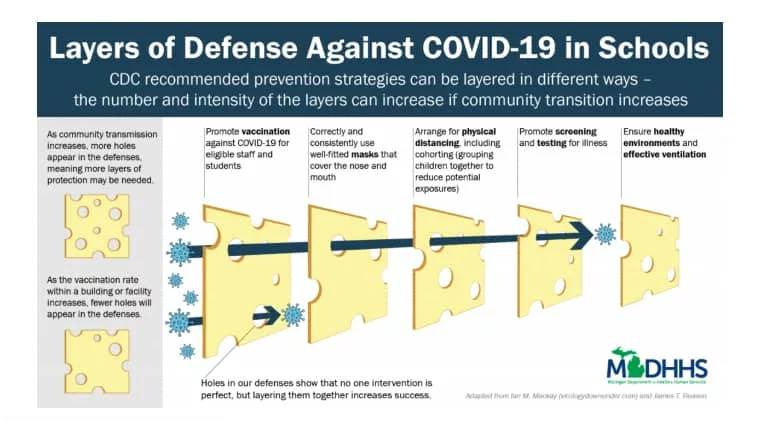With the stated goal of helping prevent transmission of COVID-19 within school buildings across Michigan in an effort to reduce disruptions to in-person learning and help protect those who are not fully vaccinated, the Michigan Department of Health and Human Services (MDHHS) has today issued recommendations for schools going forward.
Dr. Joneigh Khaldun, Chief Medical Executive and Chief Deputy for Health at MDHHS, says, “I am pleased with the progress of our vaccination efforts in Michigan, with 56-percent of Michiganders age 12 and older having received at least their first dose of the safe and effective COVID-19 vaccine,” and adds, “These vaccines are the reason transmission of the virus in Michigan is at the lowest point in a year. However, as the school environment brings together large groups of individuals who may not yet be vaccinated, MDHHS is issuing this guidance to help protect Michiganders of all ages.”
You can see the guidance document produced by the department, including the graphic shown accompanying this story, by clicking this link:
COVID-19_Guidance_for_Operating_Schools_Safely_728838_7
To help schools prepare for the return of people to indoor settings in the fall, the guidance outlines mitigation measures designed to protect students, teachers and staff, and maintain in-person learning. Schools can layer multiple prevention strategies developed by the Centers for Disease Control and Prevention (CDC) to reduce transmission of the virus within school buildings.
That will help minimize disruptions to in-person learning and help protect the people who are not fully vaccinated, which currently includes all children under the age of 12 years. All prevention strategies provide some level of protection, and layered strategies implemented at the same time provide the greatest level of protection.
Key prevention strategies in schools include:
- Promoting COVID-19 vaccination for eligible staff and students.
- Correctly and consistently using well-fitted masks that cover the nose and mouth. CDC recommendations for when to wear a mask in school settings.
- Social Distancing: Physical distancing, including cohorting children together to reduce potential exposures.
- COVID-19 Screening, Testing and Contact Tracing
- Encouraging students and staff to stay home if sick or having COVID-19 symptoms.
- Encouraging students and staff to get tested for COVID-19 if having symptoms or if they are not fully vaccinated and are a close contact of someone who has COVID-19.
- Conducting screening
- Implementing contact tracingand quarantine, collaborating with the local health department.
- Maintaining Healthy Environments
- Promoting handwashing and covering coughs and sneezes.
- Routine cleaning to help maintain healthy facilities.
- Avoiding crowded and/or poorly ventilated indoor activities (e.g., engaging in outdoor activities when possible and increasing ventilation for indoor activities).






